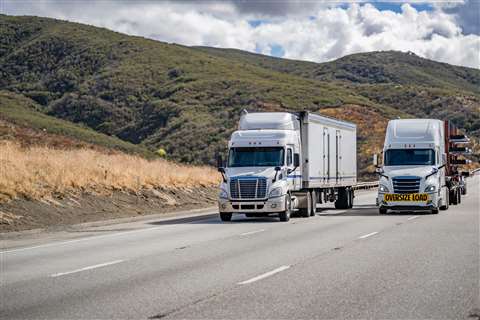CARB OKs Advanced Clean Fleets rule
28 April 2023
One day after passing new rules aimed at reducing emissions from locomotives, the California Air Resources Board (CARB) has approved a first-of-its-kind rule that requires a phased-in transition toward zero-emissions medium- and heavy-duty vehicles.
The Advanced Clean Fleets rule is intended to put California on a path toward accomplishing Gov. Gavin Newsom’s goal of fully transitioning trucks operating in the state to zero-emissions technology by 2045. CARB said the new rule will generate $26.6 billion in health savings from reduced asthma attacks, emergency room visits and respiratory illnesses, while saving fleet owners an estimated $48 billion in their total operating costs from the transition through 2050.
 The California Air Resources Board has approved the Advanced Clean Fleets rule that is intended to fully transition trucks operating in the state to zero-emissions technology by 2045. (Photo: Adobe Stock Photo)
The California Air Resources Board has approved the Advanced Clean Fleets rule that is intended to fully transition trucks operating in the state to zero-emissions technology by 2045. (Photo: Adobe Stock Photo)
The state aims to invest almost $3 billion between 2021 and 2025 in zero-emission trucks and infrastructure, part of a $9 billion multi-year, multi-agency zero-emissions vehicle package to decarbonize the transportation sector that was agreed upon by the governor and the state legislature in 2021.
“We have the technology available to start working toward a zero-emission future now,” said CARB Chair Liane Randolph. “The Advanced Clean Fleets rule is a reasonable and innovative approach to clean up the vehicles on our roads and ensure that Californians have the clean air that they want and deserve. At the same time, this rule provides manufacturers, truck owners and fueling providers the assurance that there will be a market and the demand for zero-emissions vehicles, while providing a flexible path to making the transition toward clean air.”
Transition to start in 2024
Under the new rule, fleet owners operating vehicles for private services such as last-mile delivery and federal fleets such as the U.S. Postal Service, along with state and local government fleets, will begin their transition toward zero-emission vehicles starting in 2024. Existing vehicles can continue to operate through their useful life, CARB said.
Due to the impact that truck traffic has on residents living near heavily trafficked corridors, drayage trucks will need to be zero-emissions by 2035. All other fleet owners will have the option to transition a percentage of their vehicles to meet expected zero-emission milestones, which the agency said gives owners the flexibility to continue operating combustion engine-powered vehicles as needed during the move toward cleaner technology. Last mile delivery and yard trucks must transition by 2035, work trucks and day cab tractors must be zero-emission by 2039, and sleeper cab tractors and specialty vehicles must be zero-emission by 2042.
The rule also allows fleet owners to receive exemptions based on available technology to make sure fleet owners continue to replace their older polluting trucks with ones that have new low-emissions engines. There are already about 150 existing medium- and heavy-duty zero-emission trucks that are commercially available in the U.S. today, the agency said.
Engine-powered truck sales to end in 2036
The Advanced Clean Fleets rule mandates an end to combustion engine truck sales in 2036, a first-in-the-world requirement. The rule also provides fleet owners flexibility and provides regulatory certainty to the heavy-duty market, the agency said.
An analysis of the sales and purchase requirements estimates that about 1.7 million zero-emission trucks will hit California roads by 2050. To support the needed infrastructure and services to make this transition, agencies across government have committed to the Zero-Emission Infrastructure Joint Agency Statement of Intent. For more than a decade, California has been making investments in infrastructure and to support the development and adoption of zero-emissions vehicles. The Joint Statement of Intent lays out the basic tools for direct communication and collaboration between CARB, the California Energy Commission, the California State Transportation Agency, California Transportation Commission, California departments of Transportation, General Services and the governor’s Office of Economic and Business Development. These agencies will plan, develop, deploy and help to fund the extensive network of electric charging and hydrogen stations required to help get California to zero-emissions by 2045.
As part of the vote, board members also directed staff to coordinate with relevant state agencies on how non-fossil biomethane from sources related to the state’s wastewater and food waste diversion requirements can be used in hard-to-decarbonize sectors as part of the transition, and to report to the Board, by the end of 2025 actions needed to accomplish the transition.
Advanced Clean Fleets follows the 2020 adoption of the Advanced Clean Trucks rule, which put in place a requirement for manufacturers to increase the sale of zero-emission trucks and its waiver was recently granted by the U.S. Environmental Protection Agency (EPA).
ATA critical of new regulations
American Trucking Associations President and CEO Chris Spear issued a statement saying that the new regulation ignores the fact that zero-emission vehicles are early-stage technologies and the infrastructure to support them does not exist.
“Fleets are just beginning to understand what it takes to successfully operate these trucks, but what they have learned so far is they are significantly more expensive, charging and refueling infrastructure is nonexistent, and ZEVs are not necessarily a one-for-one replacement—meaning more trucks will be needed on California roads to move the same amount of freight,” Spear’s statement said. “California is setting unrealistic targets and unachievable timelines that will undoubtedly lead to higher prices for the goods and services delivered to the state and fewer options for consumers.
“As it becomes clear that California’s rhetoric is not being matched by technology, we hope the board will reverse course and allow trucking companies the freedom to choose the clean technologies that work best for their operations.”
Spear added, “We continue to say, ‘Yes’ to advancing cleaner technologies, but achievable targets and realistic timelines matter.”
CONNECT WITH THE TEAM








